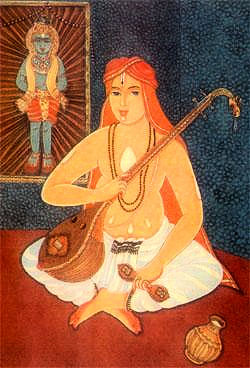

Kompiliert von Alois Payer
Zitierweise | cite as:
Payer, Alois <1944 - >: Musikinstrumente und Musikensemble. -- (Materialien zur karnatischen Musik ; 7). -- Fassung vom 2017-03-31. -- URL: http://www.payer.de/karnatischemusik/karnatisch07.htm
Erstmals veröffentlicht: 2009-05-06
Überarbeitungen: 2017-03-31 [Ergänzungen] ; 2009-05-20 [Ergänzungen] ; 2009-05-12 [große Ergänzungen]
©opyright: Creative Commons Licence (by, no commercial use)
Dieser Text ist Teil der Abteilungen Musik von Tüpfli's Global Village Library
| "At the present day,
however, it is absolutely impossible for anyone to gather an
accurate knowledge of the principles of Hindu music without the aid
of learned natives, a practical acquaintance with the capabilities
of their instruments, and without consulting the best living
performers—things that few persons have opportunity or leisure to
attempt." Day, C. R. (Charles Russell) <1860-1900>: The music and musical instruments of southern India and the Deccan. -- London & New York : Novello, 1891. -- xvi, 173 S. : Ill. ; 25cm. -- S. 7 |
"Musikinstrumente, die die erforderlichen Eigenschaften haben, sind vierfach:
Bezogen meint Saiteninstrument, umbunden meint Trommel, Festkörper meint Zimbel, durchlöcherter Hohlkörper meint Flöte. " Bharatamuni: Nāṭyaśāstra XXVIII.1 - 2. |
Wer welche Instrumente spielt, ist bis heute noch zum Teil Kasten-spezifisch. Da für Brahmanen Tierhäute und Speichel unrein sind, vermieden sie, Trommeln oder Aerophone zu spielen. Erst Ende 19. / Anfang 20. Jahrhundert überwanden einzelne Brahmanen dieses Tabu. So der Mṛdaṅgam-Spieler T.S. Palghat Maṇi Ayyar (geboren 1912/13 - 1981) und der Flötist Śarabha Śāstrigaḷ (1872 - 1904). An den Fürstenhöfen musizierten Brahmanen und Nicht-Brahmanen in denselben Ensembles, es wurde aber streng auf Einhaltung der Statushierarchie (z.B. durften Nāgasvram-Spieler nicht sitzen, mussten mit nacktem Oberkörper spielen, Brahmanen wurden zuerst mit Blumenkränzen geehrt, auch wenn sie nicht die Solisten waren) geachtet.
Außer den unten genannten Instrumenten werden von einzelnen Musikern die verschiedensten westlichen (auch elektronischen) oder nordindischen Instrumente verwendet.
Vgl. z.B. auf Spotify:
Sitar (सितार
/
ستار ) von Arun Shankar:
URI:
spotify:album:7C5zvm2aUziNmPGqjrRNtG
URL:
https://open.spotify.com/album/7C5zvm2aUziNmPGqjrRNtG
Santur (سنتور) von Arun Shankar:
URI:
spotify:album:2w69XOh4xBRZw56aLrY3an
URL:
https://open.spotify.com/album/2w69XOh4xBRZw56aLrY3an
Bassflöte von Arun Shankar:
URI:
spotify:album:2Ylxa4qTcYVtgGHbd5kIeE
URL:
https://open.spotify.com/album/2Ylxa4qTcYVtgGHbd5kIeE
Trompete von Arun Shankar
URI:
spotify:album:76Yx6T3CTkRETT5DrtFBHE
URL:
https://open.spotify.com/album/76Yx6T3CTkRETT5DrtFBHE
Keyboard von K. Sathyanarayanan:
URI:
spotify:album:1pfwP2W4n2cymy9QUcgJNf
URL:
https://open.spotify.com/album/1pfwP2W4n2cymy9QUcgJNf
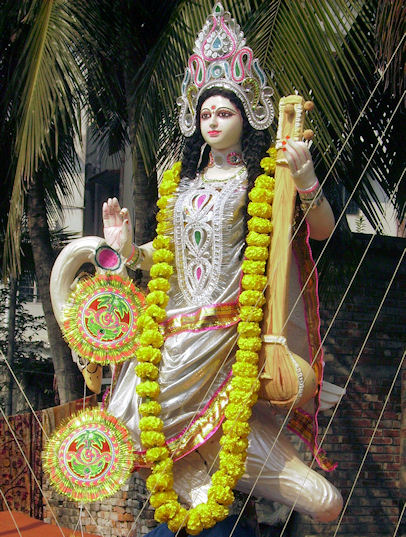
Abb.: Sarasvatī mit Vīṇā
[Bildquelle: Christina Kundu / Wikipedia. -- GNU FDLicense]
Während die nordindische Vīṇā eine Stabzither ist, ist die südindisceh Vīṇā eher eine Langhalslaute.
Die südindische Saraswati Vina hat Bünde und entspricht wie die Sitar einer Langhalslaute, nur ist das ganze Instrument aus einem Stück Holz gefertigt. Der bauchige Korpus (kudarn) ist an der Decke abgeflacht. Ein zweiter, kleiner Resonator (soraikkai) aus Kürbis befindet sich unter dem Wirbelkasten. Diese Vina liegt beim Spielen quer vor dem Musiker. Der Korpus ruht dabei auf dem Boden, der Hals wird durch die beiden Knie des Spielers waagrecht gehalten. Der Hals endet oberhalb des Wirbelkastens als Yali Mukha mit dem Kopf eines Fabelwesens. Mit den Bordunsaiten kann bei der Saraswati Vina [...] die rhythmische Struktur (tala) gleichzeitig mit den Tönen (svaras) des Raga wiedergegeben werden. Die Möglichkeit, damit das Gesamtkonzept der indischen Musik darstellen zu können, macht die Wertschätzung dieser Instrumente aus."
[Quelle: http://de.wikipedia.org/wiki/Vina. -- Zugriff am 2009-05-05]
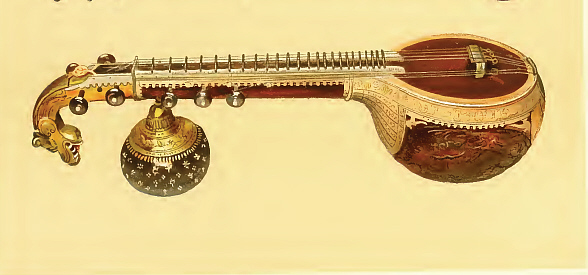
Abb.: Vīṇā
[Bilquelle: C.R. Day, a.a.O., Plate II]
"The instrument to the left of the plate [II.] represents the Vina in common use in Southern India. Though in Northern India and the Deccan the use of the vina, or bin, is restricted to professional musicians or skilful performers, we do not find this to be the case in the South. This instrument is taught in the schools in many places, and is a very favourite one with amateurs of the higher classes. The specimen here represented is about 250 years old, and is from the collection at the Tanjore palace. The delicacy of the carving and the great wealth of decoration bestowed upon this instrument are remarkable, and prove it to have belonged to some very distinguished personage—probably to one of the Maharajahs of Tanjore.
The vina is a stringed instrument, with frets, played with the fingers, or rather finger-nails, somewhat in the same manner as a mandoline or guitar.
Its construction, however, renders it for purposes of melody a far more perfect instrument than either of the latter, and although its tones are not so full and rich, its compass is larger, and it is, in skilled hands, capable of producing a much greater variety of effects.
Its tone, judged from a European standard, is rather thin, but curiously soft and plaintive. It is somewhat like that of the Tyrolese zither, which, however, it exceeds in fulness, and it is capable of infinitely more expression.
The vina has seven strings, four pass over the frets (twenty-four in number), three shorter strings are placed at the side of the finger-board, and are employed chiefly as a kind of accompaniment or to mark the time used by the performer.
[p.112]
The four large strings are termed saranis and are named thus :—
Sarani: 1st, thinnest, steel.
Panchami: 2nd, steel.
Mandaram: 3rd, brass or silver.
Anumandaram 4th, thickest, brass or silver.
The three side strings are termed pakha-saranis and are of steel.
[...] [p.114]
The method of playing upon the vina is rather different from that of other Indian instruments. The left hand is employed to stop the strings on the frets, the right hand to strike with.
[p. 115]
Strikes are called "mehtu," and are of three kinds, viz.:—
Kutra-mehtu.
Toda—mehtu.
Gotu—mehtu.
The right hand is employed thus : the wrist is laid almost upon the edge of the belly, and the hand is slightly arched upwards ; the first and second fingers are above, and are used to strike the large strings, all strikes being made with the nail downwards. Players upon the vina purposely allow the nails of the right hand to grow rather long, for this instrument is never played with plectra. The side strings are sounded by the third and fourth fingers of the right hand moved upwards.
The first exercise that a pupil learns is to strike one of the large strings (downwards) simultaneously with one of the side strings (upwards), a more difficult feat to accomplish than might be at first supposed.
These simple strikes are called gotu mehtu. The kutra mehtu is accomplished by striking the same string twice—first with the forefinger and then with the second finger—so as to produce a repetition of the same sound.
The toda mehtu, or etouffe, is made by striking a string with the forefinger and then gently stopping the vibration with the second finger so as to produce a staccato sound.
The left hand is used for all work upon the frets.
As was the case with the lute, the melody is chiefly played upon the first string—the chanterelle, in fact—which is commonly stopped by the first and second fingers placed together.
The fourth string is stopped by the thumb—the others, when required, by the middle and third fingers.
The least difference of pressure upon the frets causes a variation in the pitch, of which use is made in all grace and embellishments.
A species of transient shake styled "rekhu" is of frequent occurrence ; it is produced by the string when stopped being slightly pressed, and at the same time pulled out of the straight line. This will raise the pitch to any degree required, not exceeding a major third, beyond which it is found that the string usually breaks.
The performer can thus produce graces of all kinds, embracing intervals less than semitones, which can be clearly distinguished by the ear.
Another effect called "rava" is produced by the string being stopped upon one fret and being beaten by a finger upon the next fret above. [P. 116]
This, when combined with rekhu, adds considerably to the capability of the instrument, and it must be remembered that the string can be kept in a state of vibration very much longer than in the guitar, owing to its thinness in proportion to its length.
The use of glisse, as with the guitar, is frequent."
Day, C. R. (Charles Russell) <1860-1900>: The music and musical instruments of southern India and the Deccan. -- London & New York : Novello, 1891. -- xvi, 173 S. : Ill. ; 25cm. -- S. 111 - 116.
Durch den Einsatz von Kontaktmikrophonen (eingeführt von S. Balachander) sind neuartige Toneffekte möglich geworden, wie sehr lang nachklingende Töne.
Der Affengott Hanumān und der Dämonenfürst Rāvaṇa gelten als Viṇā-Virtuosen.
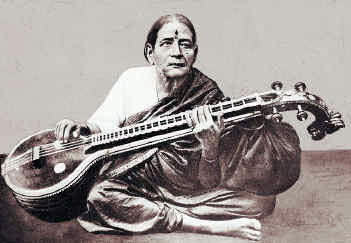
Abb.: Veena Dhanammal (Vīṇā Dhanammāḷ) (1868 - 1938) mit Vīṇā
[Bildquelle: Wikipedia. Public domain]
Vīṇā Dhanammāl hat einen großen Einfluss auf Spieltechnik und Stil vieler Vīṇā-Spieler.
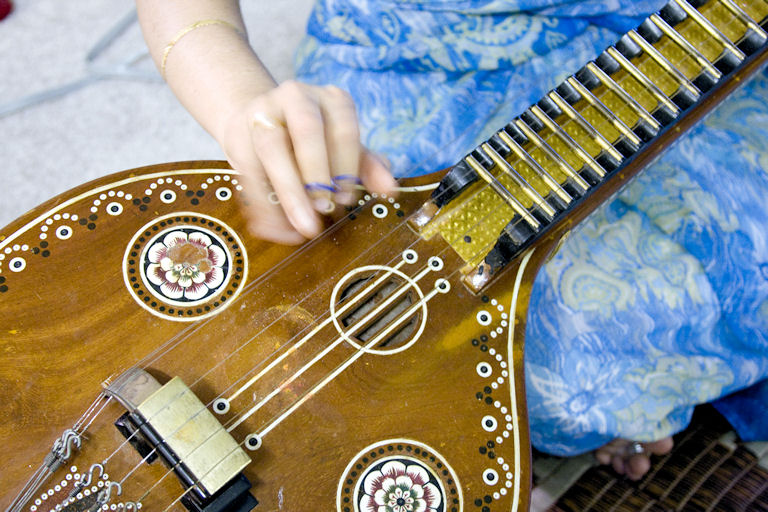
Abb.: Vīṇā-Spiel
[Bildquelle: Kelvin Kay / Wikipedia. GNU FDLicense]
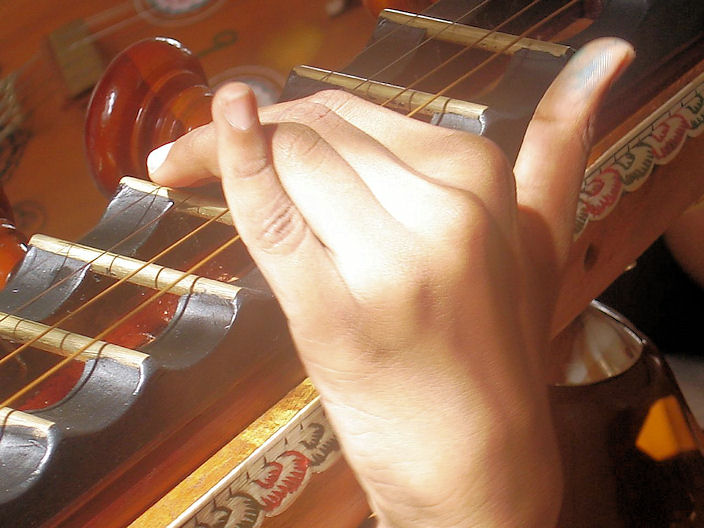
Abb.: Vīṇā, Stege
[Bildquelle: Ingsoc. --
http://www.flickr.com/photos/34761523@N00/38115093. -- Zugriff am
2009-04-14. --
Creative Commons Lizenz (Namensnennung, keine Bearbeitung)]
Vgl. folgende Alben auf Spotify:
gespielt von E. Gayathri
URI: spotify:album:00U1KfvrPjH8gn7LBHfZmt
URL: https://open.spotify.com/album/00U1KfvrPjH8gn7LBHfZmtgespielt von Rajeswari Pariti:
URI: spotify:album:3SdGYvjCITXpaUtuEkSauZ
URL: https://open.spotify.com/album/3SdGYvjCITXpaUtuEkSauZgespielt von Kalpakkam Swaminathan und S.R. Padmavathy:
URI: spotify:album:7DCTTSRPlmbdnRoi2ZmVYo
URL: https://open.spotify.com/album/7DCTTSRPlmbdnRoi2ZmVYo
Gōṭṭuvādyam ist eine bundlose Vīṇā, d.h. die Saiten werden nicht durch Bünde verkleinert, sondern allein durch den Druck mit einem Stab (N. Ravikiran benutzt einen aus Teflon).
"Form und Spielhaltung sind bei der bundlosen Gottuvadyam (auch: Mahanataka Vina) entsprechend. Diese südindische Vina wurde Anfang des 20. Jahrhunderts entwickelt und hat insgesamt 21 Saiten, davon sind 6 Melodiesaiten, 3 Bordunsaiten und 12 darunter verlaufende Resonanzsaiten (tarab). Die Gottuvadyam ist das einzige südindische Instrument mit Resonanzsaiten. Eine große Resonanzkalebasse befindet sich unter dem Wirbelkasten, sodass die Gottuvadyam waggrecht am Boden liegen kann. Sie wird mit den drei Plektrums der rechten Hand und einem Hartholzstab (auch Elfenbein) in den linken Hand, der über die Saiten gleitet, gespielt. Der bekannteste Gottuvadyam-Spieler ist N. Ravikiran (* 1967)." [Quelle: http://de.wikipedia.org/wiki/Vina. -- Zugriff am 2009-05-05]
Vgl. z.B. folgendes Album, gespielt von B.V. Balasai und A. Durgaprasad, auf Spotify:
URI: spotify:album:5lz4eeveNGjtUbOcE7tWFX
URL: https://open.spotify.com/album/5lz4eeveNGjtUbOcE7tWFX
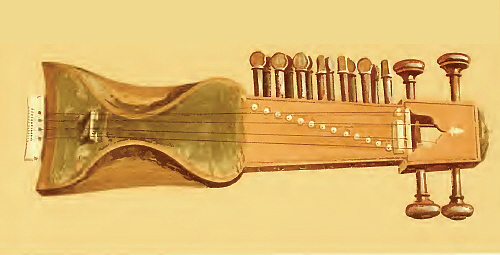
Abb.: Sāraṅgī
[Bildquelel: C.R. Day, a.a.O., Plate V]
THE Sārangi, or fiddle of India, shown to the right of this plate [V.], is usually strung with three strings of thick gut and played with a bow. Sometimes a fourth string of wire called luruj is added. The fingers of the left hand, in stopping the strings, do not press them down upon the finger-board, but press against them at the side in all the positions. The tone of the sārangi more nearly resembles that of the viola than any European instrument, and when well played there is a charm about the instrument that is not easily forgotten. The sārangi is frequently employed to play a sort of obbligato to a song, particularly in theatrical performances and by Nautch companies. There are generally in instruments of this kind fifteen sympathetic strings of wire tuned chromatically. The instrument is made from a single block of wood hollowed out, and has a parchment belly. When in use it is held vertically, head uppermost. Curiously enough, as was the case with the violin in England at one time, the instrument is considered to be rather vulgar, and hence musicians, though they admire and like it much, will usually employ either a low caste Hindu or a Mussulman to play it. The tuning is as follows:—
The string marked x is of brass, tuned either to E or F, according to the requirements of the rāga played—this string is called luruj.
The illustration shows the instrument as commonly found in the South of India and the Deccan. The resin for the bow is ingeniously placed in the head. [p. 126] The bow for the Sārangi is tlie same as that shown in Plate IV. for the Taus. In Upper India and the Punjab a slightly different form of the Sārangi is found, and is generallv more highly decorated and with a differently shaped head."
Day, C. R. (Charles Russell) <1860-1900>: The music and musical instruments of southern India and the Deccan. -- London & New York : Novello, 1891. -- xvi, 173 S. : Ill. ; 25cm. -- S. 125f.
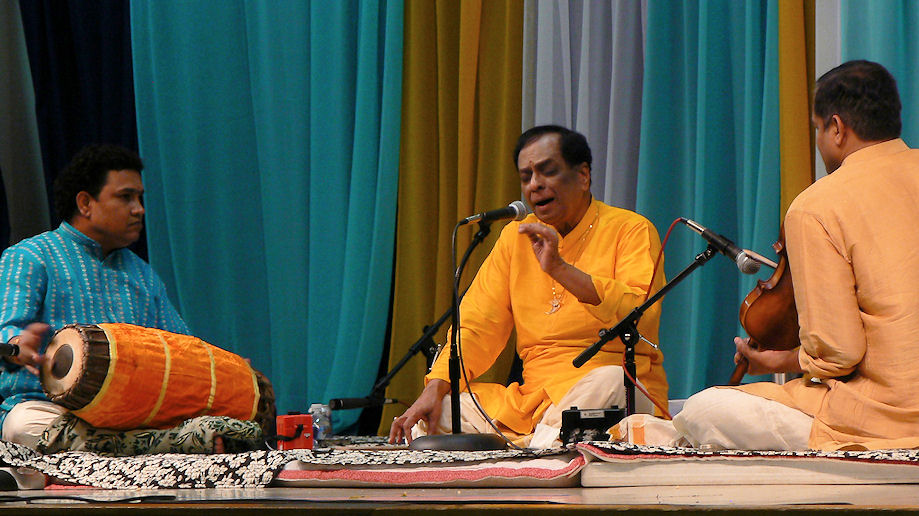
Abb.: Konzert karnatischer Musik: Gesang (Dr.M. Balamuralikrishna), Violine (Vittal
Ramamurthy), Mṛdaṅga (Thiruvarur Sri Vaidyanadhan)
[Bildquelle: balaji shankar. --
http://www.flickr.com/photos/balaji_shankar/1431714984/. -- Zugriff am
2009-04-14. --
Creative Commons Lizenz (Namensnennung, keine kommerzielle Nutzung)]
Die Violine wurde im 19. Jhdt. vor allem durch den Maratha-Herrscher von Tañjavūr (தஞ்சாவூர்), Rāja Serfoji II (सर्फोजी, சரபோஜி) (regierte 1798 - 1832) eingeführt: in seinem Palastorchester wirkte ein britischer Violinist, Jon Sylvester. Da die Violine keine Bünde hat und auch sonst zu differenziertestem Ausdruck gebracht werden kann, ist sie ideal geeignet für karnatische Musik. Heute ist sie das wichtigste Melodieinstrument in karnatischen Musikensembles und hat auch als Soloinstrument große Bedeutung.
Vgl. z.B. folgende Alben auf Spotify:
gespielt von T.N. Krishnan:
URI:URL:
gespielt von Kunnakudi Vaidyanathan:
URI: spotify:album:2Q2JVcEJMyvEufcCkJU8Pq
URL: https://open.spotify.com/album/2Q2JVcEJMyvEufcCkJU8Pqgespielt von Lalgudi G. Jayaram:
URI: spotify:album:2f0RFuCI9pe4kklekafyZI
URL: https://open.spotify.com/album/2f0RFuCI9pe4kklekafyZI

Abb.: Tampūrā
[Bilddquelle: Allauddin / Wikipedia. -- GNU FDLicense]
Tampūrā ist das wichtigste Instrument für den in der karnatischen Musik obligaten Bordun, d.h. die Dauertöne, die die Melodie tragen.
Die Tanpura (auch: Tambura) gehört zu der Familie der Langhalslauten und ist ein indisches Saiteninstrument. Sie wird als Borduninstrument verwendet und erzeugt einen obertonreichen Klang. Meistens ist sie aus dem harten Holz des Brotfruchtbaumes geschnitzt.
Die Tanpura hat meistens vier oder fünf Metallsaiten. Diese sind auf einen Grundton und dessen Quinte und Oktave gestimmt und werden ungegriffen gezupft."
[Quelle: http://de.wikipedia.org/wiki/Tanpura. -- Zugriff am 2009-05-05]

Abb.: Tampūrā
[Bildquelle: C.R. Day, a.a.O., Plate VII]
"THE Tamburi shown to the left of the plate is used as a common accompaniment to singing, the strings are never stopped, but are always struck open by the fingers, which in this case are not armed with plectra. In outer form the Tamburi much resembles the vina, but is less complicated, having no frets or calabash affixed to the stem ; and it is employed for accompaniments only. There are four strings tuned thus—
The first, second, and third are of steel, the fourth of brass ; the steel strings are similar to those of the vina. The Tamburi has no side strings ; the tuning pegs are placed differently to those of the vina ; those of the first and second strings being placed at the side, as in a violoncello ; and those of the second and third strings being placed at right angles to the centre of the head as in a banjo or peghead guitar.
The bridge is moveable, and is entirely of wood or ivory, no metal being employed in its fitting. The tone of a Tamburi is slightly buzzing, and to procure this result pieces of quill or silk, termed jivala, are placed between the bridge and strings, and manipulated until the desired effect is obtained.
The nut is deeper than in the vina, the strings passing through holes instead of slits. In many tamburis there is a contrivance called tekkah, resembling [p. 130] in action the capo-tasto of a guitar, sliding on the finger-board, and by means of it the pitch of tlie instrument can be immediately altered to any degree required by the performer.
The strings are secured directly to the attachment, which is a narrow ledge fixed to the body, instead of to langarus as sometimes is the case in the vina. In place of langarus, and for the purpose of assisting in tuning, there are beads called pusalu, threaded upon the strings between the bridge and the attachment to which they are secured. These beads pushed down in the direction of the attachment act like a wedge between the belly and the strings, and thus stretching the strings serve to alter their pitch as required. This contrivance is found in many Indian instruments.
The method of fastening the strings to the attachment is worthy of note, and is as follows. The string is bent round the attachment and passed upwards through one of the holes ; it is then bent round itself and passed back through the same hole when it is drawn tight, and the spare portion, if necessary, cut off.
The belly of the instrument is usually slightly convex, and there are small circles of sound holes cut like those of the vina. When played the Tamburi is always held upright, the body resting upon the ground. The tamburis of the Southern parts of India are generally made with wooden bodies, beautifully carved and ornamented with ivory, as in the illustration ; farther North they are found with bodies of gourd. Some of the finest instruments of this kind are made at Tanjore, where their manufacture has been made a subject of special study, and large prices are frequently paid for them.
All instruments of this kind are called Tamburis, and many varieties may be found ; one kind frequently met with is made smaller and with a curved head like that of the vina, and is used by mendicant singers.
Those of the kind described are used only by musicians and are styled " Dasiri Tamburi.""
Day, C. R. (Charles Russell) <1860-1900>: The music and musical instruments of southern India and the Deccan. -- London & New York : Novello, 1891. -- xvi, 173 S. : Ill. ; 25cm. -- S. 129f.
Aus Kostengründen (um einen Musiker einzusparen) wird heute die Tampūrā oft durch eine elektronische Tampūrā, elektronische Tongeneratoren, Tonband oder Śrutipeṭṭi (Śruti box) ersetzt.
Vgl. die Alben Tambura Sruti von J. Balaji auf Spotify:
Künstlerlink auf Spotify:
URI: spotify:artist:6UhamGcj0dyurWuaFDfnom
URL: https://open.spotify.com/artist/6UhamGcj0dyurWuaFDfnom
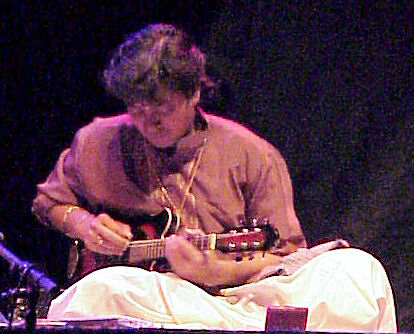
Abb.: Mandolin Upalappu Shrinivas, München, 2001
[Bildquelle: Sven Petersen / Wikipedia. Gemeinfrei]
Neuerdings fand durch Mandolin Upalappu Shrinivas (ఉప్పలపు శ్రీనివాస్), (1969 - ) auch die Mandoline, ein mit einem Plektron gespieltes lautenartiges Zupfinstrument, Eingang in die karnatische Musik.
Künstlerlink auf Spotify:
URI: spotify:artist:4s196lUJ9b3DB9YqSDxCd9
URL: https://open.spotify.com/artist/4s196lUJ9b3DB9YqSDxCd9

Abb.: Ektār
[Bildquelle: C.R. Day, a.a.O., Plate VII]
"The Yektar, or Tuntuni as it is sometimes called, shown in the centre of the plate, can hardly be called an instrument at all, since it has only one string and no frets. [p. 131] It is made from a piece of bamboo, to the under side of which a large gourd or hollow cylinder of wood is attached, one end being closed by a piece of parchment. In the centre of the parchment there is a hole, through which the string is passed and tied in a knot to prevent its slipping back.
The Yektar is often used by mendicants, and is twanged from time to time as an accompaniment to their monotonous chanting. In villages and country districts in the Deccan and Central Provinces this instrument is very popular. It is used in conjunction with a drum of some kind, and the performers keep up a sort of monotonous dialogue upon some common topic of village interest, which is full of witty and rather broad remarks about the principal personages present."
Day, C. R. (Charles Russell) <1860-1900>: The music and musical instruments of southern India and the Deccan. -- London & New York : Novello, 1891. -- xvi, 173 S. : Ill. ; 25cm. -- S. 130f.
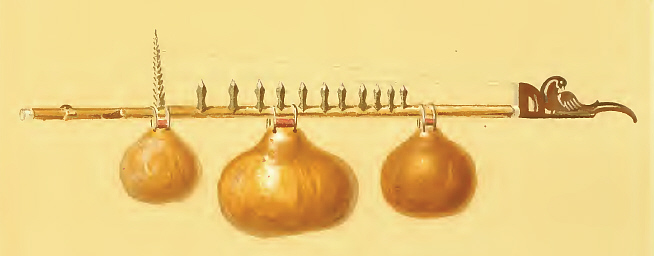
Abb.: Kinnarī
[Bildquelle: C.R. Day, a.a.O., Plate IX]
"THE Kinnari is a rude stringed instrument employed chiefly by the country people in South Kanara and Mysore. It is somewhat singular that a stringed instrument of much the same name—the Kinnor—should have been mentioned in the Bible, and this leads one to conjecture that they may both have been derived from the same Aryan source ; for the Kinnari is an instrument of great antiquitv, and takes its name from the legend that it was invented by Kinneri, one of the gandhārvas or singers of Brahma-loka, the heaven of the god Brahma. It is formed out of a piece of bamboo or blackwood, about 2 feet 6 inches in length, upon which are placed frets, sometimes made from the scales of the pangolin or scaly ant-eater (bone or metal however is generally used), and fixed by means of some resinous composition. Beneath this stem are fixed three gourd resonators.
The instrument possesses two strings only, made of wire. One of these strings passes over the frets, the other is fixed rather above the frets, and is tuned either a fourth or fifth below the former, according as the instrument is tuned in Panchama or Madhyama śruti.
The frets are twelve in number, and are placed according to the intervals of some particular scale or scales. Hence the compass and capability of the Kinnari are naturally limited. The tone is weak and thin, and the twanging of the strings renders the instrument unpleasant to ears not accustomed to it.
Most of the Sanskrit treatises upon musical instruments contain some mention of the Kinnari, or kinnari-vina as it is sometimes called. It is worthy of note that the tailpiece of the instrument is still invariably carved to represent the breast of a kite, precisely as directed in all the old treatises ; and in many of the old sculptures to be seen on temples and shrines in the Mysore country this instrument is so represented."
Day, C. R. (Charles Russell) <1860-1900>: The music and musical instruments of southern India and the Deccan. -- London & New York : Novello, 1891. -- xvi, 173 S. : Ill. ; 25cm. -- S. 135.
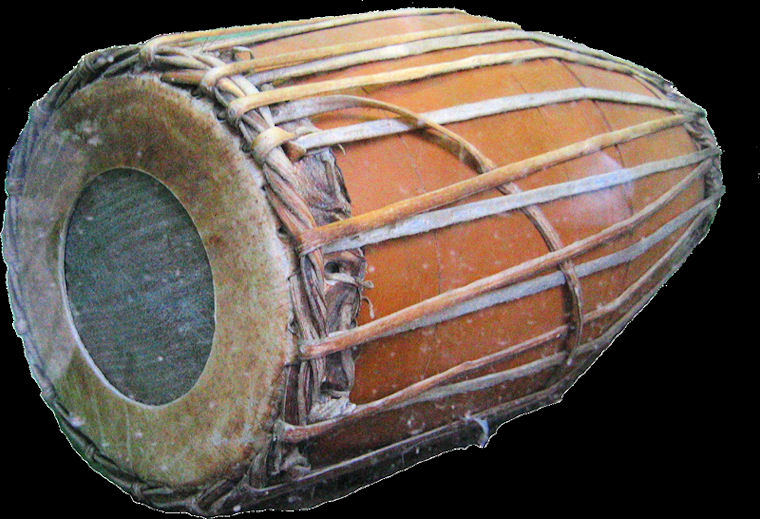
Abb.: Mṛdaṅga
[Bildquelle: Ranveig / Wikipedia. -- Public domain]
"Mridangam ist eine Doppelmembrantrommel, die in Südindien gespielt wird. Die Mridangam ist das wichtigste begleitende Rhythmusinstrument der karnatischen Musik und damit von der Bedeutung vergleichbar mit der Tabla in der klassischen nordindischen Musik. Von der Form entspricht sie der nordindischen Pakhawaj.
Das Wort „Mridangam“ ist die südindische Variante der Sanskrit-Wörter „mṛd“ (Ton oder Erde) und „aṅga“ (Körper). Während das Instrument früher aus gehärtetem Ton hergestellt wurde, findet inzwischen ausschließlich Holz wegen seiner höheren Dauerhaftigheit Verwendung. Mit der Entwicklung des Instruments einhergehend verfeinerte sich auch das System der Talas (in südindischen Sprachen: talam) und wurde zu einem der komplexesten Systeme von Rhythmik in klassischer Musik.
Die Mridangam ist eine zweiseitig bespannte Trommel, deren Korpus aus einem ausgehöhlten Stück Jackfruchtholz besteht. Die Wände sind etwas zweieinhalb Zentimeter dick. Die beiden Öffnungen sind mit Ziegenhäuten bespannt und diese sind miteinander durch Lederstricke verbunden. Auf diese Weise werden die beiden Membranen gespannt. Die Breite der Membranen ist auf beiden Seiten verschieden, wodurch mit einem Trommelinstrument zwei verschiedene Tonhöhen erzeugt werden können. Durch Befeuchten des Ziegenleders (meist der kleineren Membran) und Aufbringen einer Paste aus Reismehl und Wasser in der Mitte der Membran stimmt der Spieler das Instrument vor einem Auftritt.
Die Mridangam wird auf dem Fuß und Bein des Musikers liegend gespielt, ein Rechtshänder schlägt die kleinere Membran mit seiner rechten Hand, die größere mit der linken, ein Linkshänder umgekehrt.
Die Mridangam fand und findet auch in musikalischen Prozessionen und religiösen Festivals Verwendung."
[Quelle: http://de.wikipedia.org/wiki/Mridangam. -- Zugriff am 2009-05-05]
Patron der Mṛdaṅga-Spieler ist der Stier Nandī, Śivas Reittier.
Vgl. folgende Alben auf Spotify:
Gespielt von P.S. Devarajan:
URI: spotify:album:3fDdGpm2bL0fFrHAEUAsMr
URL: https://open.spotify.com/album/3fDdGpm2bL0fFrHAEUAsMrgespielt von T.V. Gopalakrishnan:
URI: spotify:album:4csCyVQY2DyG2b2Hm2pze0
URL: https://open.spotify.com/album/4csCyVQY2DyG2b2Hm2pze0gespielt von Rohan Krishnamurthy:
URI: spotify:album:2Mq6gr28eMDG4P2tsvNQLe ; spotify:album:5bX3iQiO3XUKZeyfithmbH ; spotify:album:1P49OENPy3lFb2xWI5CGO6
URL: https://open.spotify.com/album/2Mq6gr28eMDG4P2tsvNQLe ; https://open.spotify.com/album/5bX3iQiO3XUKZeyfithmbH ; https://open.spotify.com/album/1P49OENPy3lFb2xWI5CGO6
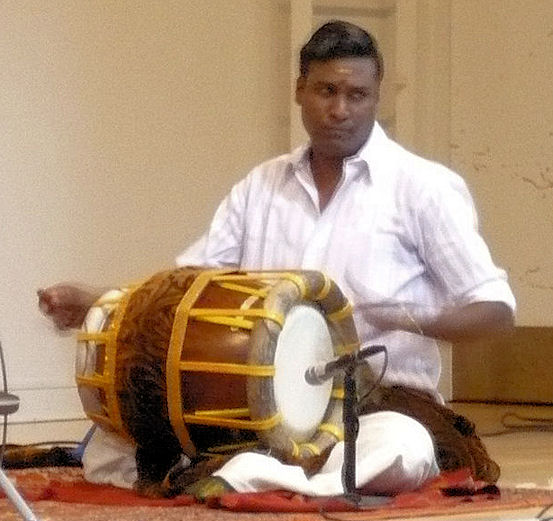
Abb.: Tavil
[Bildquelle: Badagnani / Wikipedia. -- GNU FDLicense]
"The thavil (Tamil: தவிள்) is a barrel shaped percussion instrument from South India. It is used in folk music and Carnatic music, often accompanying the nadaswaram. The thavil and the nadaswaram are essential ingredients of traditional festivals and ceremonies in South India. The thavil consists of a cylindrical shell hollowed out of a solid block of jackfruit wood. Layers of animal skin (water buffalo on the right, goat on the left) are stretched across the two sides of the shell using hemp hoops attached to the shell. The right face of the instrument has a larger diameter than the left side, and the right drum head is stretched very tightly, while the left drum head is kept loose to allow pitch bending.
The instrument is either played while sitting, or hung by a cloth strap (called nadai) from the shoulder of the player. The right head is played with the right hand, wrist and fingers. The player usually wears thumb caps on all the fingers of the right hand, made from hardened glue made from maida flour. The left head is played with a short, thick stick made from the wood of the portia tree. It is not uncommon for left-handed players to use the opposite hands, and some nadaswaram groups feature both a right- and a left-handed thavil player.
In folk music contexts, a pair of longer, thinner sticks is sometimes used."
[Quelle: http://en.wikipedia.org/wiki/Tavil. -- Zugriff am 2009-05-05]
Tavil-Solo auf Spotify:
gespielt von Bangalore Muniratnam:
URI: spotify:track:1Tjxqz2cRCzsXYmivi2UY7
URL: https://open.spotify.com/track/1Tjxqz2cRCzsXYmivi2UY7
Vgl. z.B. folgende Alben auf Spotify:
gespielt von T.A. Kaliyamurthy
URI: spotify:album:60s2EvwT6dZmvhPhkVIsjp
URL: https://open.spotify.com/album/60s2EvwT6dZmvhPhkVIsjpgespielt von Haridwaramangalam A.K. Palanivel:
URI: spotify:album:7nbvczLFNyFM64qWOcsBXC
URL: https://open.spotify.com/album/7nbvczLFNyFM64qWOcsBXCgespielt von Valaiapatti A.R. Subramaniam
URI: spotify:album:7zapBi83vkVcth70bWPPxg
URL: https://open.spotify.com/album/7zapBi83vkVcth70bWPPxg
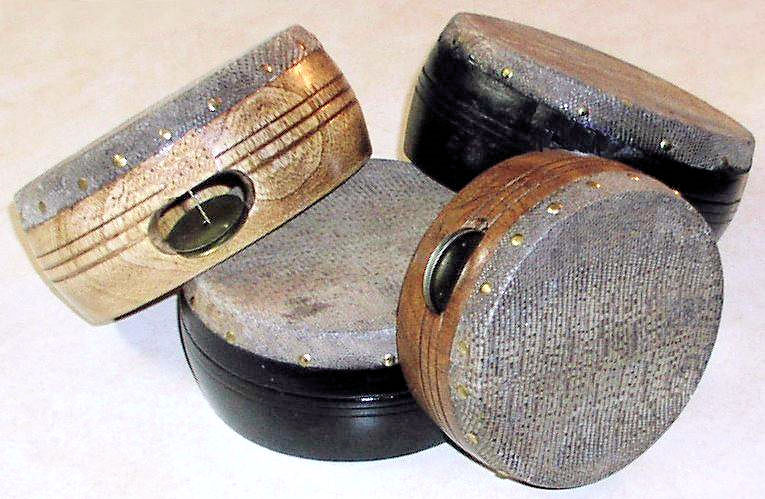
Abb.: Kañjīrā
[Bildquelle: brian@silverbushmusic.com / Wikipedia. -- GNU FDLicense]
"Die Kanjira ist ein kleine Rahmentrommel aus Südindien mit einem einzelnen Schellenpaar. Sie wird zur Begleitung der klassischen Musik Südindiens benutzt. Die Kanjira ähnelt in groben Zügen dem westlichen Tamburin, im Gegensatz zu diesem wird jedoch bei der Kanjira seltener von den Schellen Gebrauch gemacht. Sie wird in der linken Hand gehalten und mit den Fingern und Handballen der rechten Hand gespielt. Durch die lockere Spannung des Felles (traditionell meist Echsenhaut), sind Modulationen der Tonhöhe während des Spiels möglich. Eine Technik die auch bei der der Bayan der nordindischen Tabla verwendet wird."
[Quelle: http://de.wikipedia.org/wiki/Kanjira. -- Zugriff am 2009-05-05]
Die meisten Mṛdaṅga-Spieler spielen auch Kañjīrā. Es gibt aber auch einige Kañjīrā-Spezialisten.
Kañjīrā auf Spotify:
gespielt von V. Nagarajan
URI: spotify:track:40HeNr0PDGOwHaGQINwElV
URL: https://open.spotify.com/track/40HeNr0PDGOwHaGQINwElVgespielt von T.N. Shashikumar
URI: spotify:track:0J7ziCtsi8KuAN3F2MBvsB
URL: https://open.spotify.com/track/0J7ziCtsi8KuAN3F2MBvsB
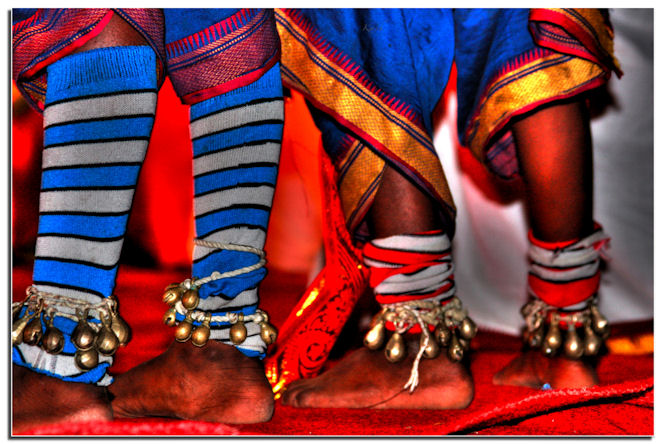
Abb.: சலங்கை = Salangai, Chennai
[Bildquelle: ஃ முதல் அ வரை. --
http://www.flickr.com/photos/myriadity/3215396378/. -- Zugriff am
2009-05-06. --
Creative
Commons Lizenz (Namensnennung, keine kommerzielle Nutzung, keine
Bearbeitung)]
Zu den Idiophonen gehören auch die verschiedenen Glocken, Glöckchen und Schellen, z.B. Salangai (சலங்கை = calaṅkai), die auf Schnüren aufgezogenen oder auf Bänder genähten Schellen an den Fußknöcheln von Tänzerinnen und Tänzern.
Ein weiteres wichtiges Idiophon sind die Hände: Händeklatschen spielt teilweise eine bedeutende Rolle als Rhythmusinstrument.
Ein wichtiges Idiophon der karnatischen Musik ist der Fußboden. Durch gekonntes Stampfen mit den Füssen verwandeln gute Tänzerinnen den Fußboden in ein faszinierendes Musikinstrument.
Ein Paar kleiner Zimbeln, mit dem der Nattuvānar, idealerweise der Guru der Tänzerin oder des Tänzers, Musiker und Tänzer "dirigiert".
Holzstock (taṭṭupalakai) und Holzblock (taṭṭukali), mit denen Tanzfiguren und Rhythmus vor allem beim Unterricht gezeigt werden.
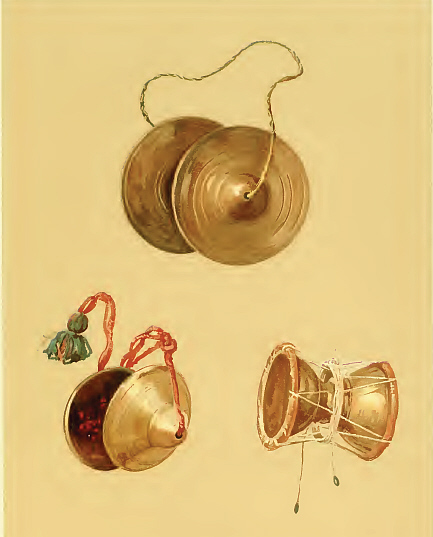
Abb.: Tāḷam, Jālrā und Budbūdika
[Bildquelle: Day, C. R. (Charles Russell) <1860-1900>: The music and musical instruments of southern India and the Deccan. -- London & New York : Novello, 1891. -- xvi, 173 S. : Ill. ; 25cm. -- Pl. 13.]
Tāḷam sind Handbecken als Rhythmusinstrument, die in der karnatischen Musik vom Tanzmeister (naṭṭuvanar) oder vom Sänger gespielt werden. Eine größere Version des Talam wird in der Tempelmusik benutzt.
Jālrā entspricht dem Tāḷam, ist aber aus dünnerem Metall hergestellt und wird von Bhajana-Gruppen und musizierenden Wanderasketen verwendet.
"METAL cymbals of all kinds are used as accompaniments to native music. Farther North we find them chiefly in connection with music of a religious character, but in the South their use is universal. The larger kinds, called Jhanj, are much like the ordinary Turkish cvmbals and are used in the Nahabet, and in company with the Tāla, or gong, in the wild temple music. The chief use made of all cymbals is to mark the time. The two small kinds of cymbals here drawn are peculiar to Indian music. The Jālra—shown uppermost in the plate—are made in proportion a good deal thicker than the larger cymbals, and they are played so as to produce a ringing sound, somewhat like that of a trembling electric bell ; they are usually connected by a cord passed through their centres. The cup-shaped cymbals to the left of the plate are called Tāla, and are so made that their edges only are struck. Tāla are in size similar to Jālra, but are not usually connected.
At the back of each a tassel of silk or wood serves for a handle. Colonel Meadows Taylor thus describes their use : "One is held in the left palm secured by a cord passed round the right, and is struck by the other, which is held loosely in the right. Players on these Cymbals are extremely dexterous, and produce a not unpleasing accompaniment to the voice or to instrumental music, by striking the cups together in such a manner—outside, inside, and upon the edges—as to form notes in accordance with the voice or the other instruments by which it may be accompanied. This cymbal accompaniment is played with more execution than may be conceived possible from the nature of the instrument. [p. 144] I have heard professors even play solos upon it, which, if not very intelligible as to tune, were at least curious in execution and diversity of lime, as suited to the various style of music.""
Day, C. R. (Charles Russell) <1860-1900>: The music and musical instruments of southern India and the Deccan. -- London & New York : Novello, 1891. -- xvi, 173 S. : Ill. ; 25cm. -- S. 143f.
Zwei Holzstäbe mit Metallgriff, auf denen kleine Scheibchen aus Glockenbronce sind. Wird vor allem von musizierenden Wanderasketen verwendet bei ihren Harikathā`s - viṣṇuitischen Erzählgesängen.
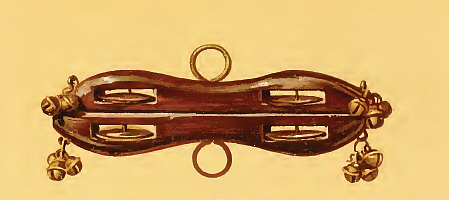
Abb.: Kurtar / Chittika
[Bildquelle: C.R. Day, a.a.O., Plate XIV
"Kurtar, or Chittika, are two pieces of hard wood about six inches in length, flat upon one side and rounded upon the other. They are held in the one hand and the flat surfaces beaten together by alternated closing and opening the fingers. A ring is usually inserted at the back of each for the fingers to pass through, and at the ends are placed little clusters of bells, or small pieces of metal which jangle when the Kurtar is shaken." Day, C. R. (Charles Russell) <1860-1900>: The music and musical instruments of southern India and the Deccan. -- London & New York : Novello, 1891. -- xvi, 173 S. : Ill. ; 25cm. -- S. 145.
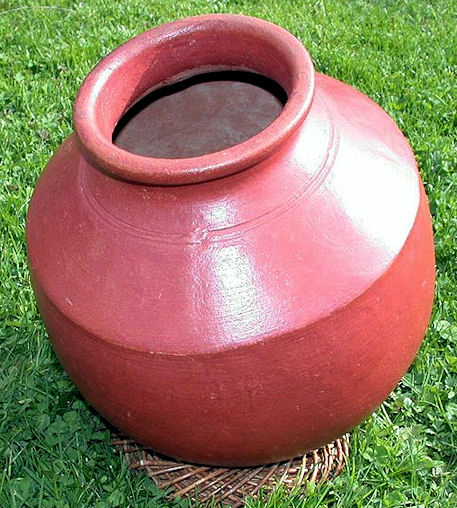
Abb.: Ghaṭam
[Bildquelle: Sven Petersen / Wikipedia. Public domain]
"Ghatam ist ein bauchiges, traditionell aus rotem Ton gebranntes Perkussionsinstrument, das in Südindien heimisch ist. Meistens wird sie auf dem Schoß oder auf einem Standring (Vattam) mit den Fingern angeschlagen, wobei man beim Schlagen auf verschiedene Teile des Korpus viele Töne und Variationen bekommt. Unterteilt ist die Ghatam in Vai, den Mund und die Öffnung der Ghatam, die mit der Handfläche angeschlagen wird und einen warmen Basston ergibt. Außerdem kann man mit leichtem Öffnen und Schließen des Mundes den Klang variieren, der auf dem Korpus gespielt wird. Der Hals der Ghatam heißt Kaguthu, der mit dem Uddambu, dem Bauch, den Körper der Ghatam bildet.
Die Ghatam wird in der klassischen Musik Südindiens gespielt, auch zusammen mit anderen Perkussionsintrumenten wie der Trommel Mridangam. In der westlichen Sphäre wurde die Ghatam unter anderem einem größeren Hörerkreis nahegebracht durch die Musik der von dem Jazzgitarristen John McLaughlin gegründeten Formation Shakti."
[Quelle: http://de.wikipedia.org/wiki/Ghatam. -- Zugriff am 2009-05-05]
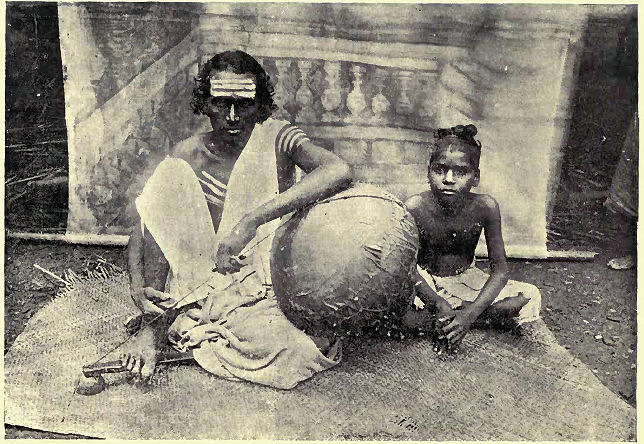
Abb.: Angehörige der Pulluvan-Kaste mit Ghaṭam
[Bildquelle: Thurston, Edgar <1855 - 1935> ; Rangachari, K.: Castes and tribes of southern India. -- Madras : Govt. Press, 1909. -- 7 Bde. : ill. ; 24 cm. -- Bd. 6. -- Nach S. 232.]
Ghatam auf Spotify:
gespielt von Thetakudi Harihara Vinayakram:
URI: spotify:track:7k3YAMbdaGQ8MfgmPQIqKY
URL: https://open.spotify.com/track/7k3YAMbdaGQ8MfgmPQIqKYgespielt von T.H. Vikku Vinayakram.
URI: spotify:album:3K23cne2UvSeWnNhbwMNHX
URL: https://open.spotify.com/album/3K23cne2UvSeWnNhbwMNHX
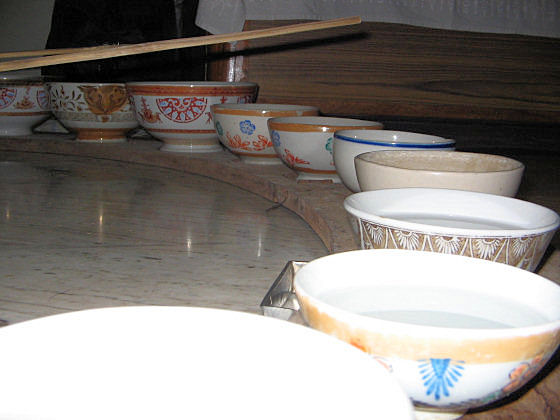
Abb.: Jalataraṅga
[Bildquelle: Ghanonmatta / Wikipedia. Public domain]
Jalataraṅga besteht aus mit Wasser gefüllten Porzellanschüsseln, die mit leichten Stöckchen angeschlagen werden. Durch die Wassermenge können die Töne gestimmt werden.
Alben mit Jalataraṅga auf Spotify:
gespielt von Nemani Somayajulu:
URI: spotify:album:1GkjqlEwlaphhy546tPhkS
URL: https://open.spotify.com/album/1GkjqlEwlaphhy546tPhkSgespielt von Anayampatti S. Ganesan:
URI: spotify:album:6PRSPHrZo9Gq4SUhdSQ7e3
URL: https://open.spotify.com/album/6PRSPHrZo9Gq4SUhdSQ7e3
"Eine Morsing ist die südindische Version einer Maultrommel und wird in der klassisch indischen Musik als Rhythmusinstrument eingesetzt. Ihr Klang ist metallisch, hoch und schneidend laut und ergänzt somit gut einen dumpferen Trommelklang. Oft werden ganze Trommelpartituren auf die Morsing umgeschrieben. Das Instrument hat einen kompakten Rahmen aus Eisen, Stahl oder Kupfer mit einer daran befestigten, freischwebenden Stahlzunge, welche lang übersteht. Der Rahmen wird nun mit der Handmuschel der linken Hand gehalten und an die leicht geöffneten Zahnreihen angelegt. Mit dem Mittelfinger der rechten Hand zupft der Spieler nun die Stahlfeder an, welche den Klang mittels Modulation des Mundraums und der Atmung erzeugt."
[Quelle: http://de.wikipedia.org/wiki/Morsing. -- Zugriff am 2009-05-06]
Beispiele für Mōrsing auf Spotify:
gespielt von Thetakudi Harihara Subhashchandran:
URI: spotify:track:0WGJJq63jGKIEDPXgIVJAv
URL: https://open.spotify.com/track/0WGJJq63jGKIEDPXgIVJAvgespielt von Thetakudi Harihara Subhashchandran:
URI: spotify:track:6Md5hO6jpJ7guQGla1bJBE
URL: https://open.spotify.com/track/6Md5hO6jpJ7guQGla1bJBE
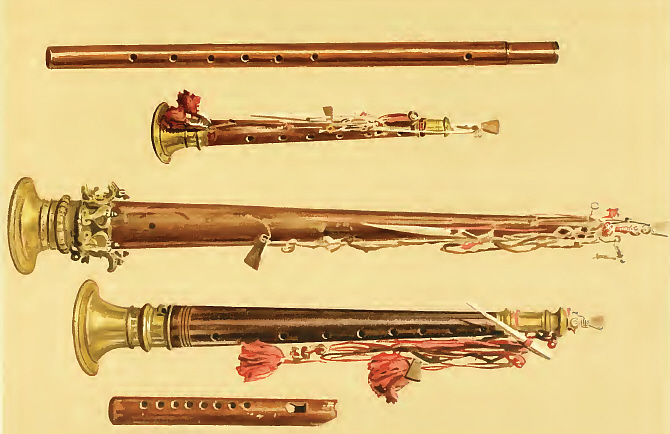
Abb.: (von oben nach unten:) Pillagovi (Murali), Mukhavīṇā, Śruti,
Nāgasvara, Algoa
[Bildquelle: C.R. Day, a.a.O., Plate XV]
"THE three instruments in the centre of the plate belong to the same class, and are in general use in all parts of India. The Nāgasāra—the second from the right in the plate—is a reed instrument with a conical bore enlarging downwards. It is usually pierced in twelve holes, the upper seven of which alone are employed in fingering, the others being stopped or otherwise with wax at the discretion of the performer, so as to regulate the pitch of the instrument. The holes are bored at intervals roughly corresponding to those of some Indian scale, but the native players often produce other and additional intervals by allowing the fingers to only partially cover the holes.
The reed somewhat resembles that of a bassoon, but it is very roughly made, and is wider in proportion to its length ; it is mounted like that of an oboe, on a short metal "staple."
The instrument is usually made of a dark close-grained wood called chandanna, and has a metal bell. Occasionally nāgasāras made entirely of metal are met with.
The tone is somewhat similar to that of a bagpipe, but is more shrill, and should be heard at a distance.
The Mukavina—the second from the left in the plate—bears a close resemblance to the nāgasāra, but is usually much smaller, about half the size. It is an instrument of the oboe family, with a conical bore enlarging downwards. It is pierced in seven holes corresponding to the intervals of some [p. 148] scale, and is capable of the same inflections of tone. Its sound is naturally more shrill than that of the former, and is very piercing, which renders the instrument very unpleasant to ears not accustomed to it.
Both the nāgasāra and the mukavina when played in combination with other instruments are accompanied by the Śruti, which forms a kind of drone bass. These drones are made in various sizes, and in outward appearance are very similar to the two instruments before-mentioned. The bore is conical and enlarging downwards, but more so in proportion to the length of the instrument than in either of the other two. Four or five holes are pierced near the bell at the fancy of the maker ; and these holes, by being stopped wholly or partially with wax, serve to tune the śruti to the desired pitch. When played in combination with other instruments they are tuned to the tonic and dominant ; if only one śruti is employed it is tuned simply to the tonic.
The appendages to these pipes are spare reeds and an ivory bodkin for their adjustment.
Whether we may look to India for the origin of the drone bass is a doubtful point, but it is certain that the principle has existed there from very remote times.
"What bagpipes are to Scotland or Ireland, these pipes are to India. Their sound is precisely similar to that of bagpipes, only, perhaps, more powerful, and in the hands of good players more melodious. They have seven and eight holes respectively, and thus would appear to have no great compass ; but in execution, whether from the effects of the lips and tongue upon the reed mouthpiece, or the manner of fingering upon the holes, combinations are formed which include semitones and quarter notes, and thus the expression of chromatic passages ad libitium, of which the native players are very fond, is given, which in reality are very effective. From their great power of sound these pipes are unpleasant if the performers be near; but at a distance, in the open air, and specially among the mountains, the effect is much subdued, and often attains much wild beauty and softness. They are in fact the only regular outdoor instruments of Indian music, and are employed on all occasions, whether in domestic or public religious ceremonials, processions, or festivals, temple music, and the like ; and the music played upon them varies with the occasion on which they are used. Marches and military music exceedingly like pibrochs in character—pieces for marriages, for rejoicings, for funerals, welcomings, departures—familiar ballad airs and the stated music of the Nahabet have all separate modes and effects. In the Mahratta country, in [p. 149] which I know them best, the simple melodies of the people, joyous or plaintive, are performed with a style of execution often surprising ; and combinations of musical effect are introduced which are equally curious and interesting."
These pipes are also known as Holar-cha-Surnai and Hola-cha-Sur, or simply Surnai.
The flute to the left of the plate is the Pillagovi, or Murali, made of bamboo, and traditionally believed to have been invented by the god Krishna, who is usually represented as holding it or playing it. The name Bansuli is sometimes given to this instrument.
The Nuy, or flute-à-bec, resembles the pillagovi, but has the embouchure at the end, and is bored cylindrically. The tone is low and sweet, and the instrument is invariably played softly ; indeed, notes of a piercing character could not be produced upon it. It is quite a pastoral instrument, and is much used by shepherds and cowherds. Many of the simple melodies of the country when played upon this instrument have a wonderful charm.
The Algoa—shown on the right of the plate—is a kind of flageolet of bamboo, with a tone and compass like that of the pillagovi. Instruments of this kind are found in the Punjab and Upper India, played in pairs in a somewhat similar manner to the tibiae pares of the Romans."
Day, C. R. (Charles Russell) <1860-1900>: The music and musical instruments of southern India and the Deccan. -- London & New York : Novello, 1891. -- xvi, 173 S. : Ill. ; 25cm. -- S. 147 - 149.
Zu den Aerophonen gehört auch Śaṅkha, das Schneckenhorn, ein rechtsdrehendes (= linksgewundenes) Exemplar von Turbinella pyrum (= T. rapa) ("Hinduglocke"), das nur religiös-funktional verwendet wird.

Abb.: pullāṅkulal = புல்லாங்குழல்
[Bildquelle ta-Wikipedia]
Veṇu ist eine Querflöte aus Bambus. Sie ist das Instrument Kṛṣṇas.
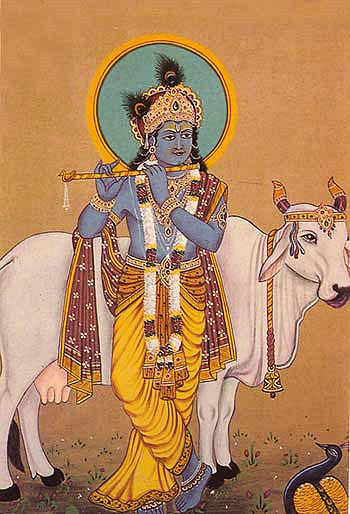
Abb.: Krṣṇa mit Veṇu
[Bildquelle: Wikipedia. Public domain]
"The fingers of both hands are used to close and open the holes. It has a blowing hole near one end, and eight closely placed finger holes. The instrument comes in various sizes. [...]
The venu is capable of producing two and half octaves with the help of blowing - overblowing and cross fingering. The flute is like the human voice in that it is monophonous and also has the two and half octaves sound reproduction. Sliding the fingers on and off the holes allows for a great degree of ornamentation, important in the performance of raga-based music.
The venu's north Indian counterpart is called bansuri (बांसुरी)."
[Quelle: http://en.wikipedia.org/wiki/Venu. -- Zugriff am 2009-05-06]
Die heutige Spieltechnik geht vor allem auf T.R. Mahalingam ("Mali") (gestorben 1985) zurück, der die traditionelle Spieltechnik revolutionierte.
Künstlerlink auf Spotify:
URI: spotify:artist:7GnQpzHOfba9tX3Vrk50vE
URL: https://open.spotify.com/artist/7GnQpzHOfba9tX3Vrk50vE
Vgl. Alben auf Spotify:
gespielt von K.S. Gopalakrishnan
URI: spotify:album:32qrq3fIk8IPd9qQpAvYuH
URL: https://open.spotify.com/album/32qrq3fIk8IPd9qQpAvYuHgespielt von Sikkil Sisters:
URI: spotify:album:6bpVsRDlvGiNmsRPEV6bJ6
URL: https://open.spotify.com/album/6bpVsRDlvGiNmsRPEV6bJ6gespielt von T.R. Mahalingam:
URI: spotify:album:3xmFbjRJbQRLG1KaZh5QWE
URL: https://open.spotify.com/album/3xmFbjRJbQRLG1KaZh5QWE
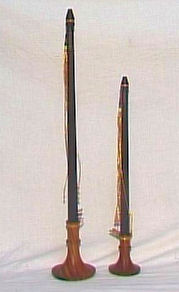
Abb.: Nādasvaram / Nāgasvaram = நாதசுவரம்
[Bildquelle: ta-Wikipedia]
"Das Nadaswaram ist eine großes indisches Doppelrohr-Blasinstrument. Es wird in den Tempeln Südindiens gemeinsam mit der Tempeltrommel Tavil gespielt. Das konisch gebohrte, etwa 85 cm lange Holzblasinstrument Barinadhaswaram ist der bekannteste Typ. Es ist in Es oder D gestimmt und verfügt über 7 Grifflöcher. Der Schalltrichter hat einen Durchmesser von 15 cm. Das Instrument wird üblicherweise aus einem mehrere Jahrzehnte lang gelagerten Ebenholz gefertigt, das Mundstück (Shiwali) besteht aus einer Schilfart. Mittels Veränderung des Lippendrucks und genauer Tonvorstellung können alle erdenklichen Raga gespielt werden. Ein bedeutender Virtuosen ist Sheik Chinna Moulana (షేక్ చిన్న మౌలాన) (1924 - 1999). In Europa wurde das Instrument durch Charlie Mariano und Roland Schaeffer bekannt." [Quelle: http://de.wikipedia.org/wiki/Nadaswaram. -- Zugriff am 2009-05-06]
Im Unterschied zu westlichen Oboe-Spielern, die das Doppelblatt zwischen den Lippen halten, schwingt das ganze Doppelblatt indischer Oboen frei in der Mundhöhle des Spielers.
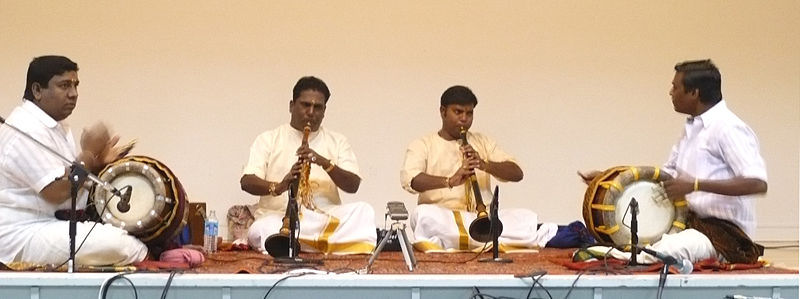
Abb.: Nāgasvaram und Tavil
[Bildquelle: Badagnani / Wikipedia. -- GNU FDLicense]
Beeispiele von Nādasvaram-Alben (Stichwirt: Nadaswaram) auf Spotify:
gespielt von Mambalam M.K.S. Shiva und M.K.S. Natarajan:
URI:URL:
gespielt von Namagiripettai Krishnan:
URI: spotify:album:2VjPn9S67v97DrGdToTxAh
URL: https://open.spotify.com/album/2VjPn9S67v97DrGdToTxAh

Abb.: Klarinette
[Bildquelle: Wikipedia. Public domain]
Die Klarinette ist ein Holzblasinstrument mit Einfach-Rohrblatt.
Die Klarinette wurde in die karnatische Musik vo Mahādeva Naṭṭuvananar ca. 1860 eingeführt. Heute wird die Klarinette in der karnatischen Musik z.B. von A.K.C. Natarajan (1930/31 - ) gepflegt.
Künstlerlink auf Spotify:
URI:
spotify:artist:1m2SOYsz6jEnohjA9Eh84A
URL:
https://open.spotify.com/artist/1m2SOYsz6jEnohjA9Eh84A
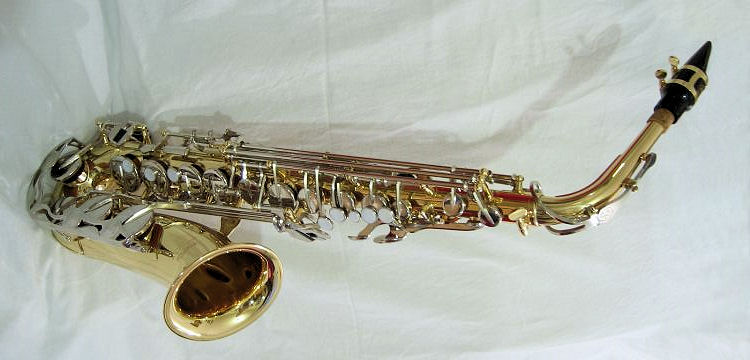
Abb.: Saxophon
[Bildquelle: Wikipedia. GNU FDLicense]
Kadri Gopalnath (ಕದ್ರಿ ಗೋಪಾಲನಾಥ) (1950 - ) aus Karnataka ist Pionier im Einsatz des Saxophons in karnatischer Musik.
Künstlerlink auf Spotify:
URI: spotify:artist:79iXBDwJoeVZZSe1AV7ta7
URL: https://open.spotify.com/artist/79iXBDwJoeVZZSe1AV7ta7
Das Saxophon ist ein Rohrblattinstrument und zählt deswegen zu den Holzblasinstrumenten.
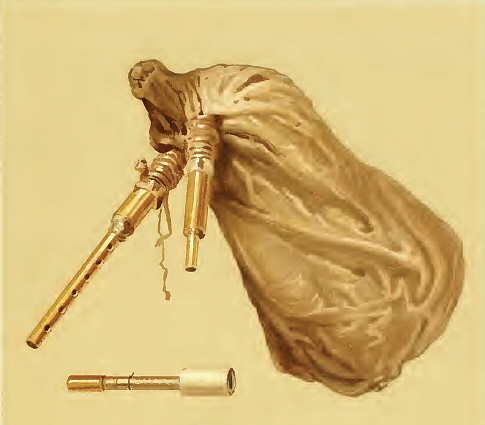
Abb.: Bhajana-śruti
[Bildquelle: C.R. Day, a.a.O., Plate XVI]
"The bagpipe here drawn is the Moshuq, or, as it is called in Southern India, Śruti-upanga or Bhazana-śruti. It is used merely as a drone ; the holes in the pipe are wholly or partially stopped with wax so as to tune the instrument to the pitch desired. The bag is made of the skin of a kid and is inflated from the mouth by means of the smaller of the two pipes shown. The drone is of cane, mounted in a stock of the same material, and which contains the reed. An enlarged drawing of the reed has been given in the plate, in order better to show its construction, and, as can be seen, the vibrations are controlled by a little piece of wire or fine twine tied roughly round the tongue. The whole reed is in one piece and is generally made of small cane or of the large marsh reeds found almost everywhere. Black wax is used to make the instrument wind-tight. The Moshuq of Northern India does not differ much in outward appearance from this, but contains a chanter, with the addition sometimes of a drone."
Day, C. R. (Charles Russell) <1860-1900>: The music and musical instruments of southern India and the Deccan. -- London & New York : Novello, 1891. -- xvi, 173 S. : Ill. ; 25cm. -- S. 151.
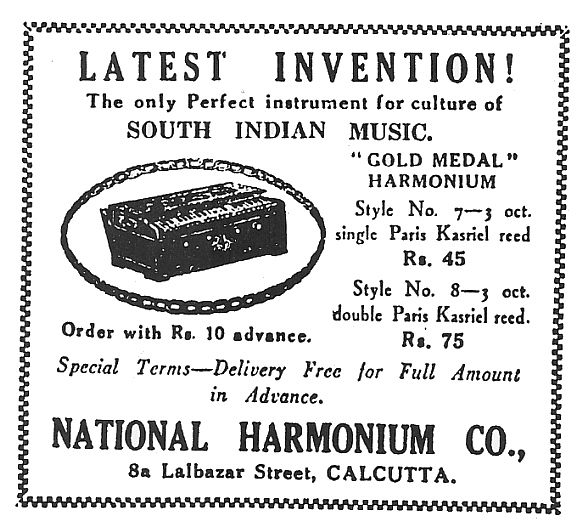
Abb.: Anzeige in The Hindu (Madras), 1930-01-29
[Bildquelle: Viswanathan, T. (Tanjore) <1927 - 2002> ; Allen, Matthew Harp: Music in South India : the Karṇāṭak concert tradition and beyond : experiencing music, expressing culture. -- New York : Oxford University Press, 2004. -- xxv, 150 S. : Ill. ; 21 cm. + 1 Audio-CD. -- ISBN: 0195145909 0195145917. -- S. 3]
Im 19. Jahrhundert führten christliche Missionare das tragbare Harmonium in Indien ein. In nordindischer Hindustāni Musik ist das Harmonium wohl das beliebteste Begleitinstrument. In Südindien ist es bei Bhaja-singenden Gruppen sehr beliebt. Das Harmonium war dabei, auch in die karnatische Kunstmusik Eingang zu finden, als in den 1930er Jahren eine intensive Kampagne gegen die Verwendung des Harmonium in der karnatischen Kunstmusik begann. Seither ist das Harmonium aus den südindischen Konzertsälen verbannt.
"Die Shrutibox ist ein Musikinstrument aus Indien zur Erzeugung von Dauertönen. Sie besteht aus einem ca. 32 x 20 x 5 cm großen Holzkasten mit Blasebalg. An der Vorderseite gibt es Einzelklappen für die Töne. Die Töne werden mit Durchschlagszungen erzeugt wie beim Harmonium. Der Tonumfang beträgt eine Oktave.
Beim Spiel wird mit der Hand Luft durch den Kasten gepumpt. Töne, deren Klappen geöffnet sind, erklingen als Dauerton.
Die Shrutibox ist ein Borduninstrument zur Gesangsbegleitung. In Indien ersetzt sie in volkstümlicher und devotionaler Musik die Tanpura der klassischen Musik. Im Westen wird sie zur Begleitung von Obertongesang verwendet."
[Quelle: http://de.wikipedia.org/wiki/Shrutibox. -- Zugriff am 2009-05-069
Beispiel für Harmonium auf Spotify:
von Palladam S Venkataramana Rao:
URI: spotify:track:5ruEM2JD4c1Tciw2VxK1B8
URL: https://open.spotify.com/track/5ruEM2JD4c1Tciw2VxK1B8
Beispiel für Śrutipeṭṭi auf Spotify:
URI: spotify:track:0ORJbhkwCdzqdEJ43aqbeQ
URL: https://open.spotify.com/track/0ORJbhkwCdzqdEJ43aqbeQ
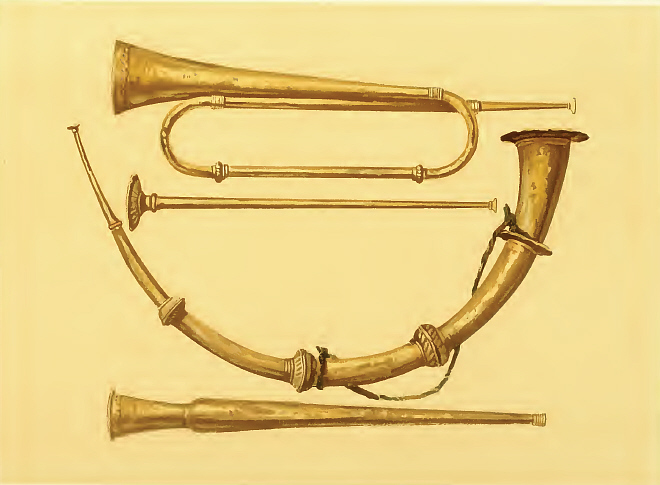
Abb.: (von oben nach unten:) Tuturi, Nafari, Kombu, Kurna
[Bildquelle: C.R. Day, a.a.O., Plate XVII]
"The curved brass horn in this plate is the Śringa or Śing, called in Southern India Kahalay or Kombu. It is frequently found with a metal rod connecting both ends. This horn is "used universally through India for signals, watch setting processions, and the like, both by Mahomedans and Hindus, though the performers for the most part are Hindus of low caste. In every village of Central or Southern India it is the business of one or more of the watchmen to blow the horn at sunset, and again at certain hours of the night, or when the watchmen go their stated rounds. In large cities every mahulla or ward has a horn-blower attached to its night-watchmen or police, and there is seldom a guard or detachment of native irregular troops without one. In all processions, temple services, and especially at marriages and other festive occasions, this horn is indispensable, and wailing blasts for the dead are played upon it at the funerals of Hindus of the lower classes and castes, or equally so at the cremation of Hindu princes. " No native authority traverses the country without one, frequently several, in his train, and as town or village are approached the great man's advent is heralded by flourishes of the instrument blown by the performer who struts at the head of the cavalcade. These blasts are answered by others from the town or village gate, whence the local authorities come out to meet the visitor and present their offerings of welcome. On these occasions the horn-blowers on both sides vie with each other in producing their grandest effects, and the discordance is generally indescribable.
"Itinerant mendicants of many classes use this instrument, both Hindu and Mahomedan, and by men in charge of droves of cattle carrying grain or merchandise, such as Brinjaris, Comptis, and others, it is sounded at intervals [p. 154] along the road to cheer up their bullocks and keep them from straggling, as well as at their departure from or arrival at one of their stages.
"In playing the high notes in many of the calls, shrill wavering cadences are produced, which have a startling and peculiarly wild effect, as heard from the wall of some ancient fortress, or from village tower and gates as night falls, and more especially in the otherwise unbroken stillness of night.'"
The large trumpet with one turn is called the Tuturi. This name is usually applied to what might be called the tenor trumpet, as distinguished from the Kurna, the large straight trumpet drawn at the bottom of the plate. The tuturi—or turi—is made in various sizes and is used principally in religious ceremonies.
The small straight trumpet is the Nafari.
The Kurna—called in Southern India Buruga or Banku—is used only on solemn occasions, and possesses but a few hoarse sounds. In fact, no Indian trumpets are capable of producing many notes, they are invariably of the most primitive description, and no attempt is made to play them scientifically : indeed, their proper compass is not even understood. Colonel Meadows Taylor, speaking of the Kurna, remarks : "These instruments are almost invariably played by Brahmins or priests attached to Hindu temples, and by persons attached to the retinues of Gurus, Swamies or spiritual princes of the country, who possess large ecclesiastical jurisdiction, and are provided with them as a mark of high rank, which is not allowable in others. Occasionally also they are met with in the nobuts, or musical establishments attached by royal permission to nobles of high rank, Mahomedan as well as Hindu ; but they do not exist in all cases, for there are distinctions in the classes of instruments according to the rank of persons privileged to play the nobut, which involve the presence or otherwise of the kurna. The kurna, or large trumpet, is esteemed by all Brahmins to be the most ancient instrument of music in existence.""
Day, C. R. (Charles Russell) <1860-1900>: The music and musical instruments of southern India and the Deccan. -- London & New York : Novello, 1891. -- xvi, 173 S. : Ill. ; 25cm. -- S. 153f.
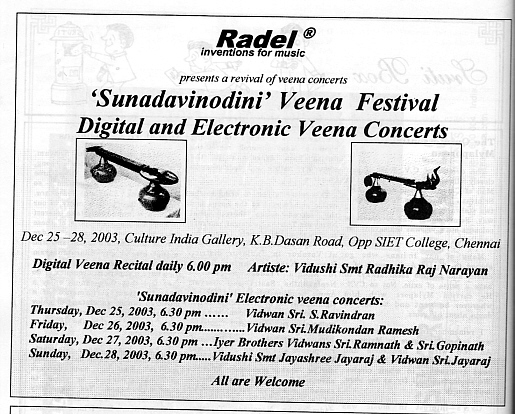
Abb.: Anzeige in: Sruti : India's premier music and dance magazine. -- Chennai.
-- Issue 231 (December 2003). -- S. 4.
Elektronisch verstärkte und modifizierte Instrumente finden zunehmend auch in karnatischer Musik Verwendung, so z.B.
Vor allem aber elektronische Instrumente für die Bordun-Begleitung: electronic Tampūrā.
Siehe z.B. die elektronischen Produkte von Radel™ "the only ISO 9001:2000 certified, award-winning company for Electronic Indian musical Instruments in the world": http://www.radelindia.com/. -- Zugriff am 2009-05-20.
"An electronic tanpura is an electronic instrument that replicates the sound of the Indian string instrument, the tanpura (tambura). In Indian music, drone is an important element. Often, drone is provided by a tanpura player, especially for vocal performances, and those of the sitar, sarod, and sarangi. The electronic tanpura was created as a marketable, practical solution for instrumentalists who cannot readily avail themselves of able tanpura players for their long hours of private practice.
Since the late 1970s, little white boxes (electronic tanpuras) appeared, first privately, then gradually coming openly to the stage as the technological sophistication of the models advanced.
In Indian solfège, called Sargam, Sa is the tonic, Ma, Pa and Ni are 4th, 5th and 7th tone degrees within the octave. Generally, the electronic tanpura has one or more dials to control the tone and volume, and may have other switches and buttons that allow a certain pitch and volume to be saved and used again at a later time. The range is usually one to two octaves.
To many, the electronic tanpura is a practical commodity. It delivers a passable substitute for a real, 'live' tanpura. Certainly, it is much easier and less expensive than maintaining a live tanpura player. However, some claim that the electronic tanpura is an inferior substitute for the actual instrument as the tones it creates lack the dynamics of a live musician, producing a mechanical, 'dead' sound.
The electronic tanpura was first invented by G Raj Narayan, an engineer-flautist from Bangalore, India, and demonstrated at the annual conference of the Music Academy Chennai in December 1979. The products were manufactured by the company he founded, Radel. The first versions were created with the technology then available, using discrete components and transistors. In the late 1990s, these gave way to models using sampled recordings of the traditional tanpura on a chip. Over the last decade, these have been further refined and the latest models can hardly be distinguished from a traditional acoustic tanpura. The success of this invention gave rise to many other players who then started manufacturing and aggressively marketing bad copies of these products. These copies have earned a bad name as the 'little white boxes' and comparisons are made to the traditional acoustic tanpuras."
[Quelle: http://en.wikipedia.org/wiki/Electronic_tanpura. -- Zugriff am 2009-05-06
Automatische Tampūrā's vor der Elektronik wurden mechanisch oder elektromechanisch angetrieben, u.a.:
Zur Stimmkultur Ende des 19. Jahrhunderts macht C. R. Day folgende Beobachtungen:
| "Native
singers rarely practise, for they think that practice, to even a
moderate extent, ruins their voices. The treatment of the voice,
too, is quite different to what experience in Europe has proved to
obtain the best results. The voices of Indian singers are almost always weak and deficient in volume—one result doubtless of their system of training, by which a full clear tone is made to give way to incessant small inflections. Girls, too, are taught singing when much too young, so that their voices either break or become harsh and shrill. A singer rarely stands while he sings, and instead of using his proper range of voice, he prefers a most unnatural falsetto, which he can rarely control, and his endeavours to make himself heard generally cause him to make the most ludicrous grimaces. Singers of this kind it is who bring Indian music into disrepute, and cause it to be regarded with contempt by European audiences. But still there are singers in India whose voices are wonderfully sweet, and when they sing their own songs in their simple form, no hearer can doubt that, like other national music, that of India possesses a charm peculiarly its own." Day, C. R. (Charles Russell) <1860-1900>: The music and musical instruments of southern India and the Deccan. -- London & New York : Novello, 1891. -- xvi, 173 S. : Ill. ; 25cm. -- S. 60 |
Eine entscheidende Wende in der Stimmkultur kam durch den universellen Einsatz von Mikrophonen.
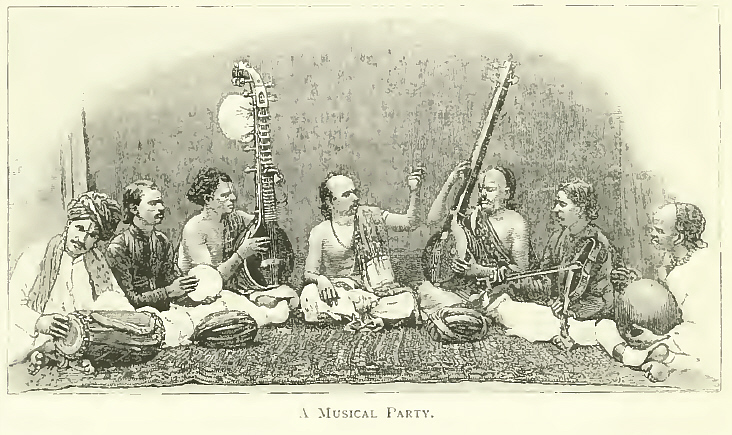
Abb.: Musikensemble
[Bildquelle: C.R. Day, a.a.O., S. 98]
|
गातृवादकसंघातो
वृन्दमित्यभिधीयते । "Eine enge Gruppe von Sängern und Instrumentalisten nennt man Ensemle (vṛnda)." Śārṅgadeva <13. Jhdt.>: Saṅgītaratnākara II.3.203ab. |
Demgemäß unterscheidet man:
गायकवृन्द = gāyakavṛnda: Gesangsensemble
वाद्यवृन्द = vādyavṛnda: Instrumentalenemble
नृत्यवृन्द = nṛtyavṛnda: Tanzensemble
R. C. Day gibt folgende Beobachtungen zur Praxis am Ende des 19. Jahrhunderts wieder:
"Musical entertainments among the higher classes are very popular and much in vogue. Upon such occasions a company of musicians are hired for the evening. The Vina is the favourite instrument, and is generally accompanied by either a Mathala or Tabla, or else by a kind of earthen pot called Gatha, much like the ordinary "chatty," which, in the hands of a skilful performer, is beaten with wonderful dexterity. Sometimes, but rarely, two vinas of different sizes are employed. In this case, if the players are skilful, the effect is very pleasing, especially in the performance of an Alāpa, a kind of rhapsody or fantasia impromptu, in any rāga ; each instrument keeps its part distinct, and the theme is cleverly imitated and tossed about from one to the other much as is done in a modern orchestra. Such imitation is, however, purely at the fancy of the performers, and not contrapuntal imitation as understood in Europe. Throughout Southern India the native drama is exceedingly popular ; the actors are generally well educated and of a high caste, and a good company always attracts full houses. Music is largely employed upon the stage, and there is a kind of orchestra attached to every native theatre. The songs sung at performances of the kind do not, as a rule, differ much from the ordinary music of the country, and of late years there has been a tendency to imitate foreign music, such as Arabian or Persian, and the English, Scotch, or other airs played by military bands at all large stations. These naturally find their way from the theatre into private houses—boys learn them and sing them in the street—and so their influence gradually extends and makes itself felt upon Indian music [p. 93] in general. The old melody types, or rāgas, are being less jealously adhered to, and the better educated classes of Hindus are beginning to see that music is not necessarily confined to one or two particular systems, but that, like nearly everything else, it is capable of improvement and further development.
A marked change for the better in the manner of singing is evident. This, indeed, could not fail to be the case when it is remembered that if a voice is intended to be heard by a large audience in a theatre or other building of the kind it must be thrown out to the full extent of its volume, instead of being contorted and its sweetness spoilt by the continued small inflections of tone and unnatural falsetto notes so much practised by native singers of the ordinary class.
The native orchestra is usually made up of the following instruments, or of a somewhat similar combination :—
Sārangi (string) 2 Tamburi (string) 1 Mukavina (native oboe) 1 Mathala or Tabla (drums) 1 Śruti (drone) 1 The use of the Sārangi in Southern India—except in conjunction with Nautches—is rapidly being discontinued, and an English fiddle tuned as a vina or sārangi is often substituted for it. Farther North the instrument appears likely to hold its place for a long time to come. A clarinet is sometimes preferred to the Mukavina.
In musical performances cymbals and bells of different kinds are used, according to taste, and the occasional use of a harmonicon of little bells or plates of metal (Septaghantika), or of porcelain cups or glasses (Jalatharāngini), is much admired.
It is a common custom for the members of particular castes, sects, &c., to meet together at stated intervals for the purpose of worship, either in each other's houses or in temples. On these occasions music forms a prominent feature, and consists of hymns of different kinds, accompanied by a variety of instruments. Music of this nature is called Bhazana [bhajana], and its use is almost universal.
Among the higher castes great trouble and expense is incurred in procuring good performers for this purpose. The songs are generally pretty and well sung to the accompaniment of the vina or sitar and tamburi, with, perhaps, a small drum to mark the rhythm. The Bhazana of the common people is a great contrast to this, and in their assemblies melody is often sacrificed to mere noise. Each man, in order to show his devotion, sings in turn, frequently with no regard for time or tune, whilst the others beat drums or blow a kind of whistle called Sillu, with other instruments, just as it pleases them, and, as can be imagined, the effect of this is discordant in the extreme. [p. 94]
The instruments commonly employed in Bhazana [bhajana] consist of one of the following combinations—
Tamburi 1 Sārangi or Fiddle 2 Mathala 1 Tamburi 1 Sārangi 1 Mathala 1 Śruti 1 Sitar 1 Tabla 1 pair Sitar 1 Tāla (cymbals) 1 Tabla 1 pair Or, if the means of the worshippers be very limited, a single tambouri, with, perhaps, one pair of little cymbals and a common drum, or tabor such as Khanjeri, is found.
The music performed for Bhazana usually consists of kirthanas, gitas, and kruthis [kṛtis].
In temples, chiefly those of Lingayet or other Saivite sects, there is a peculiar kind of music in use called Kāradisamela. It is so-called because a large conical kettle-drum called by that name is the principal instrument mployed in it. The Karadisamela carries with it a special rhythm of its own ; for lively airs—
for those of a mournful nature—
A system of music called Sopānam is found in Malabar, where it is confined to temple services. In every temple of any importance in Malabar and Travancore it is usual to have both instrumental and vocal music at the steps leading to the principal shrine during the performance of certain services. The word sopānam, in its literal sense, means " steps," and hence gives its name to this particular kind of music. The Sopānam system varies in many respects from both the Karnatik and Hindustani ; a detailed description of it would, however, be unnecessary, since it is much akin to the Karnatik system and differs only in technical points, which would be uninteresting to the reader.
The use of the gong and bell in temples is universal. Colonel Meadows Taylor, in speaking of this, remarks that the gong is not used as an accompaniment to any but the loud crashing and generally dissonant music of the temple ceremonies. No ceremony of sacrifice or oblation is ever performed without a preliminary tinkling of the bell, repeated at certain intervals according to the ritual. [S. 95] [...]
The Dasaris, a mendicant class of temple servers of Vaisnavite persuasion, usuallv employ a little side-drum, with one head only, called Dinni, not unlike the modern Egyptian " Tabl Shāmī"; other mendicants, called Andis, outcasts from Saivite sects, play upon a small gong called Semakkalam, which they beat with a stick. Both Dasaris and Andis often carry a horn as well, and support themselves by singing doleful ballads or hymns at street corners and by begging. Work of any sort they decline. The ordinary native band of discordant wind instruments, drums, and cymbals found throughout Southern India is called Mela. The players in these bands are mostly taken from a caste of Telegu-speaking barbers called " Mangala-vāndlu," who make this their special profession and provide the music, so-called, commonly heard at temple ceremonies, weddings, festal gatherings, and all street "tamāshas." The composition of these bands varies greatly, the number of instruments in some cases being as many as thirty and in others perhaps only three or four ; generally one or two nāgasāras—a śruti or drone—a drum such as the dhol—and a pair of cymbals (called Jhanj), about ten inches or a foot in diameter, are found. Sometimes a mela, consisting of a single mukavina, a flute, a flageolet, a drone, and a small side-drum called Dhanki is employed.
The effect of a mela can hardly be called pleasing, unless to those whose chief delight is discordant noise. The air, such as it is, is generally drowned by the clanging of cymbals and the incessant drumming, which, added to the prolonged and shrill drone of the śrutis, produce an effect considerably imposing. But, as Captain Willard pithily enough remarks, it is heard to advantage "from a distance."
A peculiar institution of Indian music is known as the Nahabet [or Nōbut], and is so called from that being: the name of the largest drum associated with it. There are certain persons—Hindu or Mahomedan noblemen—who are privileged to have attached to their service bands of professional musicians, who perform at certain stated hours of the day or night. This privilege is sometimes extended to certain temples and shrines of saints, or to spiritual princes—gurus or swamies. To these [p. 96] bands the name of Nahabet is given, and they are usually placed in balconies over the gateways of cities or palaces, or in other elevated places elsewhere, and these places are known as the Nahabet Khaneh. The music played is, of course, traditional, but it possesses a distinct character of its own that is entirely different to any other music heard in India, and the effect, especially among mountains or in the hill fortresses, such as are found in Central India or Rajputana, is very striking. Usuallv care is taken to retain the services of the best performers for the Nahabet, and when heard from a little distance upon a still Indian night, and the sound is subdued, there is a good deal of wild beauty about it that possesses a charm peculiarly its own.
[...]
In the present day the large number of different instruments formerly found in the Nahabet Khanehs of fortresses and palaces do not exist, and the effect of the modern Nahabet is therefore less imposing. There are, however, to be found in most Nahabet Khanehs one pair of large Nahabets, a couple of pairs of smaller kettledrums (Nakkera) and possibly other drums with a Kurna, one or two Tuturi, a pair or two of cymbals, one or two Nāgasāras and their accompanying drones, with perhaps a couple of Nuy or flutes-a-bec. [p. 97]
The Kurna is not always found, for only nobles of the highest rank are considered able to use it ; and by Brahmins it is still held to be the most ancient and sacred instrument of music in existence, and they consequently give it a prominent place in their temple ritual.
Nautch music is termed Taffa or Keylika and is performed exclusively by a caste of Nautch people called in Southern India Melakāra-jāti. This is a composite class of dancing women and male musicians, distinguished by a marked social division from the higher orders of the musical profession. The dancing men and women of the Melakāra caste, who together form a complete chorus, constitute what is called a Chinnamela (or smaller music), in distinction to the Peryamela (big music), which is a band of male musicians who play upon the Nāgasāra with drums and accompaniments differing from those of the dancers.' The Peryamela, r Pathamelam as it is also called, is the ordinary native band formed by the Mangalavāndlu caste and already described.
At Nautches the usual arrangement of instruments is as follows :
Sārangis, or English fiddles tuned in the native manner 2 Mridang or Tabla (drum) 1 Śruti-upanga (drone) 1 Tāla or jālra (cymbals) 1 [...] [p. 98]
A Nautch usually commences with the singing of a Mangala or "song of hail" (generally in the Rāga Nāta), the words of which are intended to do honour to the principal personages present. When this is concluded, the leader or conductor of the troupe, who invariably plays the tāla or jālra, hums or sings a kind of accompaniment, called Konnagolu, to this one of the girls dances, keeping time with the soft tinkling of the bells tied round her ankles. During this the other instruments are independent of the leader and are played softly and without time in any rāga that may be chosen, the chorus, if any, being much subdued. And when the dance is finished, songs—such as javadis [jāvaḷi] or pathams [padam]—follow, one voice singing the solo and the whole of the voices taking up at intervals a soft refrain. Dances or gestures, in character with the words of the song, are made by the girls performing in front of the musicians.
Sometimes Sanskrit slokes, called "Astapathi," [aṣṭapadī] are sung by one voice, the instruments playing a kind of soft, dreamy accompaniment without any well defined time, either with or alternately with the voice.
The performance is brought to a close by the singing of a Mangala, in either the rāgas Surati or Saurāshtra."
Day, C. R. (Charles Russell) <1860-1900>: The music and musical instruments of southern India and the Deccan. -- London & New York : Novello, 1891. -- xvi, 173 S. : Ill. ; 25cm. -- S. 92 - 98.
Der Tamil-Ausdruck für Musikensemle ist மேளம் = mēḷam. Man unterscheidet u.a.:
பெரிய மேளம் = periya mēḷam = Big Band: bestehend aus einem oder mehreren nāgasvaram (Oboe), einem oder mehreren Tavil (Trommel) und einem Borduninstrument (früher Ottu (ஒத்து), heute Śruti peṭṭi). Solche Ensemble treten vor allem bei Hochzeiten und Tempelfesten auf.
Vgl. das Album auf Spotify:
Inde du sud : Periya melam / Temple de Chidambaram
URI: spotify:album:7CZLs7bFD0U8ij9tDt0DRT
URL: https://open.spotify.com/album/7CZLs7bFD0U8ij9tDt0DRT
சின்ன மேளம் = cinna mēlam = kleines
Ensemble: war zur Zeit der Devadāsis (bis 1947) mit dem Tempeltanz
verbunden. Es bestand aus einem Tanzmeister (naṭṭuvanār = நட்டுவனார்), der
die rhythmischen Silben (jati) rezitiert und mit einem kleinen Paar Zymbeln
(Tālam) dirigiert, einem Vizetanzmeister, der sang, eventuell Sängerinnen,
Flötenspieler oder Mukhavīṇa-Spieler (Oboe), Mṛdaṅga (Trommel),
Bhajana-śruti (Dudelsack) als Borduninstrument. Früher stand das Ensemble
hinter der Tänzerin und bewegte sich entsprechend den Tanzbewegungen nach
vorne und hinten. Heute sitzt das Ensemble rechts von der Tänzerin. Heute
verwendet man statt mukhavīṇā eine Bambusquerflöte (pullāṅkulal) oder
Klarinette, die Vīṇā kam hinzu und Tampūrā oder Elektrotampūrā spielen statt
des Dudelsacks Bordun.
நையாண்டி மேளம் = nayāṇṭi mēḷam =
Volks-Ensemle: volkstümliche Ensemble in Ritual, Tanz und Unterhaltung. Es
besteht üblicherweise aus zwei Nāyaṇam (Oboen, etwas kleiner als
Nāgasvaram), einem Ottu (Oboe für Bordun), ein oder zwei Tavil (Trommeln),
Pampai (பம்பை) (Doppeltrommel), Kirikaṭṭi / Kuṇṭalam (zwei konische
Trommeln), Tamukku (தமுக்கு) (kleine Kesselpauke), Jālra (Zymbeln). Im
Unterschied zur karnatischen Musik ist das Tempo nicht gleichbleibend,
sondern nimmt gegen Ende mancher Stücke beträchtlich zu.
றுமி மேளம் = uṟumi mēḷam (benannt nach
der Trommel uṟumi): ein Ensemble für unheilvolle Anlässe wie Beerdigungen.
Besonders bei der Telugu-sprechenden Kampalattar Nāyakar Kaste. Besteht aus
Nāgasvaram, Pampai (Doppeltrommel) und Uṟumi (Trommel)
Viele Ādivāsigruppen haben ihre spezifischen Musikensemble.
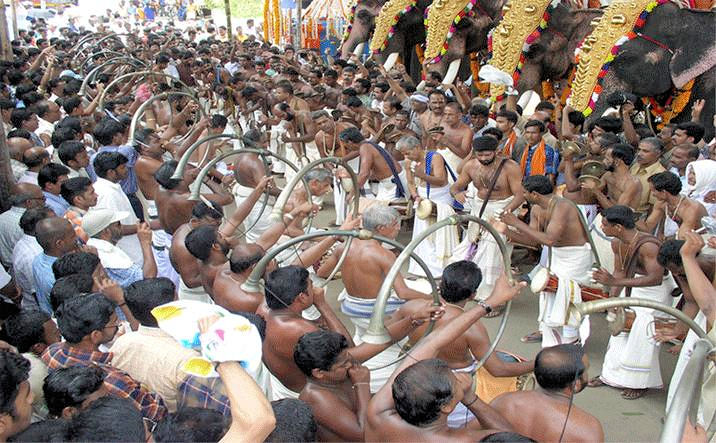
Abb.: പഞ്ചവാദ്യം = Pañcavādyam, Kerala
[Bildquelle: Kjrajesh / Wikipedia. GNU FDLicense]
पञ्चवाद्यम् = പഞ്ചവാദ്യം = Pañcavādyam sind Musikensemble an den Tempeln Keralas. Sie umfassen 20 und mehr Spieler und die fünf (pañca) Instrumente (vādya):
Dazu kommen noch:
ceṅṅala: Gong
śankha: Muscheltrompete
gelegentlich kuḷal: Oboe
Pañcavādyam-Trommler sind Angehörige der Mārār-Kaste (മാരാര്).
Vgl. das Pañcavādyam-Album auf Spotify:
URI: spotify:album:3q1QwALhFub4wUvM6G59Z2
URL: https://open.spotify.com/album/3q1QwALhFub4wUvM6G59Z2
Neben den genannten Musikensembles gibt es auch uniformierte Musikkapellen mit westlichen Instrumenten nach dem Muster westlicher Militärkapellen, die bei Hochzeitsprozessionen und anderen Prozessionen mit Vorliebe Filmmusik spielen.
Zu: 8. Musiker